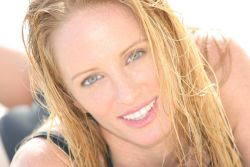 Tanya Streeter, World Record Freediver/TV Presenter/Environmentalist, becomes Ambassador for Morgan! Since retiring from competitive freediving in 2006 having broken 10 world records in the sport, Tanya has turned her focus to making environmentally sensitive wildlife documentaries. One of her best received films, "Diving With Whales" for the BBC/Animal Planet, saw her freediving with Humpback whales. Her experience while filming with these magnificent animals only served to reinforce her strong belief that marine mammals belong in the wild and never in captivity. "I am deeply saddened to learn about Morgan's incarceration, and horrified that, despite returning to good health, she is being held captive in the smallest orca enclosure in the world for the sake of entertainment. I will do whatever I can to help the FreeMorgan campaign in their goal to release this magnificent creature back into the wild."Tanya is currently working on an extremely important environmental film with the Plastic Oceans Foundation, for whom she is a patron. The film is due for cinematic release in 2013. www.plasticoceans.com
The Norwegian press is interested if Morgan is coming home soon!
“Will the saved captured orca come home to the Lofoten”
Click on the photo to link through to the website and article.
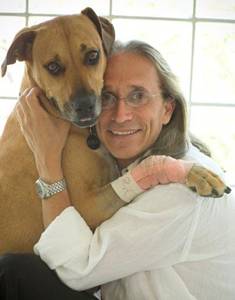 Ady Gil and Kyla Ady Gil, a world class entrepreneur, Hollywood lighting director (founding partner in California-based American Hi Definition (AHD))and internationally-recognized environmentalist and philanthropist embraced Morgan's cause and is supporting the Free Morgan Foundation for carrying out the Rehabilitation and Release Plan.
The Foundation is very grateful to this great benefactor and hopes many other will follow his lead in helping Morgan.
The verdict of Morgan’s court case will be given on 21th November 2011.
Because of the complexity of this case the judge decided to give her written
verdict within 2 weeks from now.
Until then Morgan remains in the Dolphinarium Harderwijk.
EXECUTIVE SUMMARY - 92% of the calls made by Morgan were matched to a Norwegian orca group.
- Only 0.3% of call-types were not matched to either NP or P pod.
- At least seven additional groups were matched to at least five call types.
- Morgan’s acoustic repertoire may be limited because of her confinement in a concrete barren tank and due to her young age.
- There are only extremely limited field research projects being currently conducted on Norwegian orca and further research is clearly needed.
- It is possible that the two ‘non-matched’ calls are ‘contact’ or ‘distress’ calls. Such calls would not necessarily be recorded from orca which are safely in the context of their social groups.
- Play-back of Morgan’s calls to wild orca, or wild orca calls to Morgan, has not been conducted and may provide additional information and call-types.
- 77.7% of Morgan’s call types (seven of nine) were matched to P pod.
- Only one hour of recordings of P pod were used to match these 77.7% call types.
- Not all members of P pod have been photographically identified, therefore it is not possible to ascertain if they have been present or not in Norwegian waters.
- 57% of Morgan’s call types (four of nine) were matched to NP pod (with AA+BI).
EXECUTIVE RECOMMENDATIONS- The Free Morgan Foundation strongly recommends that Morgan’s rehabilitation in Norwegian waters begins immediately.
- Concurrently, her contemporary vocal repertoire can be recorded, as well as further recordings of wild orca in Norwegian waters can be carried out, to allow refined searches to be made for Morgan’s natal group (including analyzing further databases).
- It is imperative that further delays are prevented and that the welfare of Morgan is addressed by allowing her to return to her family.
Read the full document here
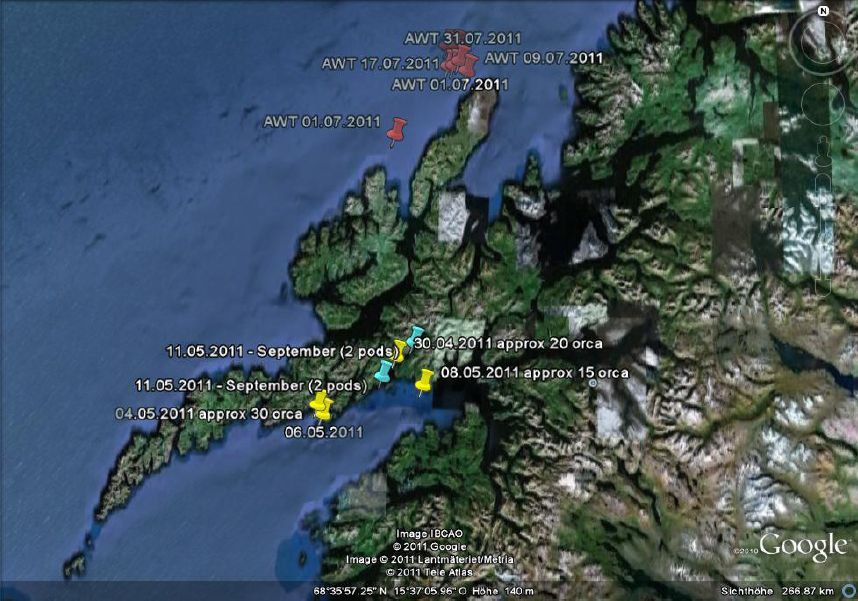 Morgan's population spotted For two summers Arctic Whale Tours reports regularly sightings of orcas near the shores of Vesteralen, Norway. Morgan belongs to this population. The links below show the weblog of Arctic Whale Tours and photos of the sightings. 2011August 2, 2011 http://arcticwhaletours.com/?p=2247July 31, 2011 http://arcticwhaletours.com/?p=2262July 17, 2011 http://arcticwhaletours.com/?p=2142July 9, 2011 http://arcticwhaletours.com/?p=2094July 2, 2011 http://arcticwhaletours.com/?p=2044July 1, 2011 http://arcticwhaletours.com/?p=2064June 26, 2011 http://arcticwhaletours.com/?p=2025June 22, 2011 http://arcticwhaletours.com/?p=1984June 21, 2011 http://arcticwhaletours.com/?p=1959June 1, 2011 http://arcticwhaletours.com/?p=18632010August 2, 2010 http://arcticwhaletours.com/?p=1286July 17, 2010 http://arcticwhaletours.com/?p=1211July 15, 2010 http://arcticwhaletours.com/?p=1199July 8, 2010 http://arcticwhaletours.com/?p=1175June 30, 2010 http://arcticwhaletours.com/?p=1149June 25, 2010 http://arcticwhaletours.com/?p=1138June 20, 2010 http://arcticwhaletours.com/?p=1095
This is another example, coming from the Northern Residents orca population in BC Canada, which have a tight family structure and offspring travelled mostly their whole life with their mother. But this story shows again that Morgan do has a chance to find her own or an extended family! Sadness and sentiment – the start of summer 2011 by Orcalab A rare April encounter brought the first hint that the A5 pod might have suffered an unexpected loss. The young adult female, Nodales (A51), was not with her family, though all the A5 matrilines were present. She and her 2010 baby were both missing. Denial, and no further sightings of the group until much later, kept faint hope alive. Perhaps she had just been missed in the stormy seas that day. As Spring rolled on and the whales began to gather further north, there were more disturbing but not entirely confirmed dispatches regarding Nodales. The pod had by then dispersed into smaller groups, so it was still difficult to draw a firm conclusion. Tension grew and then reality set in as more reports were received. Nodales’ brother, Surge (A61) was observed travelling with his A5 cousins in the A8 matriline, and Nodales’ oldest, Codero (A85) was sighted travelling with Ripple (A43)’s family. It became increasingly likely that the family bonds Nodales had nourished had come apart, and that the survivors had found new homes. Read the full story Source: Orcalab blog
Morgan remains in captivity because the Dolfinarium Harderwijk insists that her family can’t be found in the waters off Norway. However, we would like everyone to be aware of “Stumpy” a young orca from these very same waters. He apparently lost his mother and has been observed traveling with five different groups of orca. He has also been seen being provided food by these very same orca. Such flexibility in orca society shows us that we still have much to learn about them. More to the point it also show that Morgan should be given the chance to return to the wild and the orca population which she came from. Here are two pages reproduced from the book by Stenerson and Similä, which describes their findings about Stumpy. Please spread the word that keeping Morgan from her family is not the real reason the Dolfinarium Harderwijk wants to keep Morgan, but rather her value to the captive orca industry for breeding. 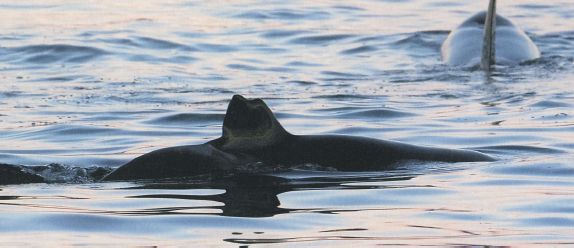 Stumpy with the NR group, resting while the other animals are hunting 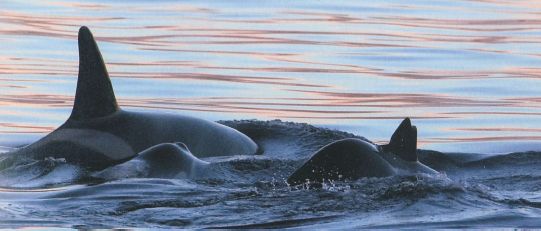 Stumpy being led away by members of the NR group Source: Stenersen, J., and Similä, T (2004). Norwegian Killer Whales. Tringa forlag ISBN: 8299457734
Far away, on an island chain off the coast of Africa, SeaWorld keeps five of their orcas; two males aged 16 and 10, two females aged 10 and 7, and one calf just 10 months old. The calf, Adan was born to the 10 year old female, who rejected him immediately – lacking the presence of an experienced mother (or any fully adult orca) as companion, and having been taken away from her own mother too young, this reaction did not come as a surprise. What is a surprise is that marine amusement parks keep breeding the orcas at such a tender age. Read more and watch the video's hereThis is the fate that awaits the young rescued orca, Morgan, which SeaWorld and Loro Parque are trying to obtain because their orcas are increasingly becoming inbred and they desperately need a fresh gene pool. Like other young female orcas in captivity, Morgan would doubtless be bred at the earliest conceivable age, and then be forced to have baby after baby, living in a concrete box her entire life.Source: Seattle PI
|

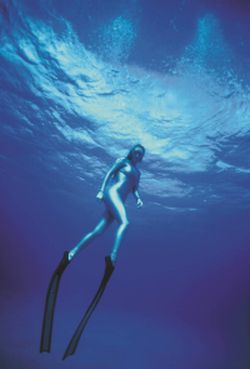
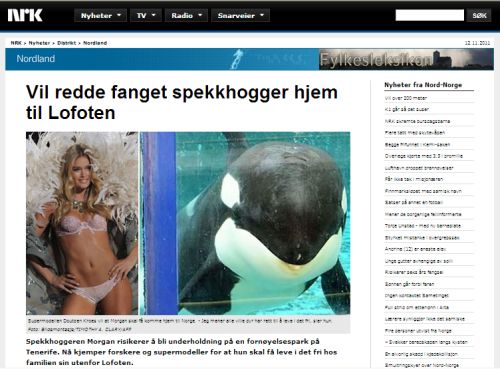

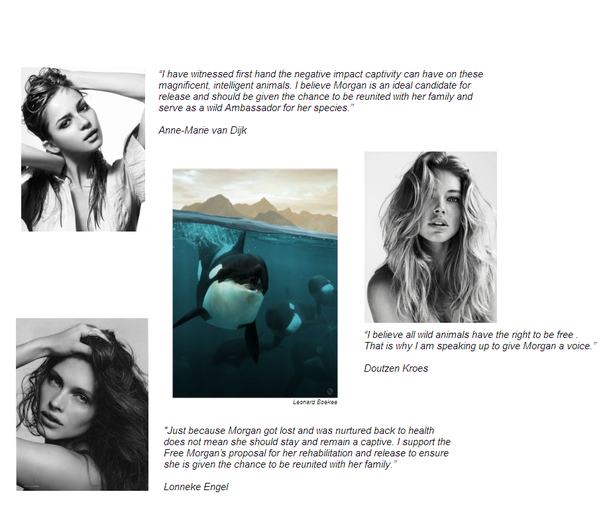



 RSS Feed
RSS Feed